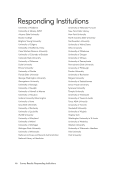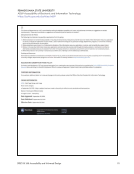4 Survey Results: Executive Summary Funding and Budgets Funding for purchases of assistive technology (such as software, hardware, and other equipment) comes from a variety of institutional budgets. Respondents indicated (fairly evenly) that funds most often come from the library operating budget, a central institutional disability budget, the library IT budget, and/or a central IT budget. A few respondents reported that funding sometimes comes from gifts, grants, donor funding, and student technology fees. Forty respondents (65%) stated that the library allocates funds for upgrades to hardware and software in the annual budget process. Only nine (20%) allocate funds to staff training pertaining to accessibility on an annual basis. Other respondents indicated that there is no annual allocation for funds but funding is provided as needed or on a case-by-case basis. Library Facilities All of the responding libraries are providing patrons some kind of workstation accommodations. Most have some general purpose public workstations that offer assistive technologies. Almost half have multi- person quiet rooms with assistive technology workstations. A number have a specialized space such as a computer lab or assistive technology center to support users who require an accommodation. But more specialized forms of accommodations—such as accessible/height-adjustable scanners, one-person quiet rooms, study carrels with assistive technology workstation, and non-fluorescent lighting—are not as prevalent. At the same time, some institutions have pursued innovative ideas such as circulating additional lighting, providing interpretypes at service desks, and making sure there are workstations close to an entrance. Many respondents commented they are using the built-in versions of assistive technologies that are standard on operating systems. They also have installed software such as JAWS, Kurzweil, Read&Write Gold, but this varies at different libraries across multiple campuses and even within various spaces (i.e., general public workstations versus accessibility labs). Other comments indicate that some libraries offer individual orientations for all self-identified students with a disability and some are providing accessibility software on all circulating laptops, and making available reservable study space/ rooms with accessibility technology or a specialized space that includes additional assistive technology. When asked how many library spaces, facilities, and service points are accessible to users with disabilities, many respondents referenced building age as an issue that limits accessibility. Several mentioned that they are undergoing renovations and with the new construction will be considering accessibility issues. Stacks accessibility appeared in several comments with one respondent stating the stacks are “horrendously” inaccessible and/or closed and therefore paging services are offered to patrons. Also, some respondents indicated that they have branch libraries or smaller libraries where patrons have to exit the library to use accessible restrooms in other parts of the building. Others commented that this question is hard to answer because some spaces might be accessible for one user while not accessible for another (i.e., door is accessible, but the space inside the room is not). At 52 of the libraries that have a specialized workspace, a user with a disability can approach a service desk to gain access to it, though the majority are self-service. About a quarter of the libraries issue a key to students who register with disability services. One respondent indicated that information about accessible study rooms and workstations is promoted on digital screens as well as the library website. Specialized Software Specialized software remains common in the surveyed libraries, and a majority provide access to both text magnification software and screen readers. The most popular options for text magnification are Adobe Acrobat’s built-in text magnification feature (47 responses, or 73%) and ZoomText (46 or 72%). This represents a significant increase in popularity for Adobe Acrobat since SPEC Kit 321, when only 55% of respondents offered Adobe Acrobat. By far the most popular screen reader is JAWS, which is offered




























































































































































